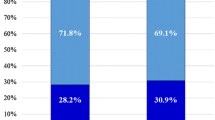Abstract
Purpose
We retrospectively reviewed infertile Japanese males for testicular volume discrepancies (D) and semen parameters to evaluate whether left grade II–III varicoceles (V) cause testicular damage.
Methods
Seventy-seven patients who had idiopathic male infertility and 88 who had V without other causes of infertility were examined. We excluded cases of azoospermia. Testicular volume was measured using a punched-out orchidometer. D was defined as a size difference of at least 3 ml. The frequency of D was compared between the patients with and without V. The semen parameters were reviewed in association with D and V.
Results
The mean left and right testicular volumes were 19.4 and 20.1 ml, respectively (p < 0.001). D with a smaller left testis was more common in V+ cases than in V− cases (26.1 vs. 13.0%, p = 0.0351). The sperm count and motility were also significantly lower (p = 0.0213 and p = 0.0217, respectively) in the D+ patients with a smaller left testicular volume.
Conclusions
In the patients with V, D was more common than in those without V. The semen parameters were worse if D was present in the patients with V. These results indicated that V could induce testicular atrophy and negatively affect semen quality. Therefore, the ipsilateral reduced testicular volume is considered to be a sign of persisting testicular damage by V.
Similar content being viewed by others
References
Nagler HM, Luntz RK, Martinis FG. Varicocele. In: Lipshultz LI, Howards SS, editors. Infertility in the Male. St. Louis: Mosby; 1997. p. 336–8.
Pryor JL, Howards SS. Varicocele. Urol Clin North Am. 1987;14:499–513.
Jarow JP, Coburn M, Sigman M. Incidence of varicocelesin men with primary and secondary infertility. Urology. 1996;47:73–6.
Kibar Y, Seckin B, Erduran D. The effects of subinguinal varicocelectomy on Kruger morphology and semen parameters. J Urol. 2002;168:1071–4.
Hsiao W, Rosoff JS, Pale JR, Greenwood EA, Goldstein M. Older age is associated with similar improvements in semen parameters and testosterone after subinguinal microsurgical varicocelectomy. J Urol. 2011;185:620–5.
Kass EJ, Belman AB. Reversal of testicular growth failure by varicocele ligation. J Urol. 1987;137:475–6.
Okuyama A, Nakamura M, Namiki M, Takeyama M, Utsunomiya M, Fujioka H, Itatani H, Matsuda M, Matsumoto K, Sonoda T. Surgical repair of varicocele at puberty: preventive treatment for fertility improvement. J Urol. 1988;139:562–4.
Gentile DP, Cockett ATK. The effect of varicocelectomy on testicular volume in 89 infertile adult males with varicoceles. Fertil Steril. 1992;58:209–11.
Sigman M, Jarow JP. Ipsilateral testicular hypotrophy is associated with decreased sperm counts in infertile men with varicoceles. J Urol. 1997;158:605–7.
Gorelick JI, Goldstein M. Loss of fertility in men with varicocele. Fertil Steril. 1993;59:613–6.
Takihara H, Sakatoku J, Fujii M, Nasu T, Cosentino MJ, Cockett ATK. Significance of testicular size measurement in andrology. I. A new orchiometer and its clinical application. Fertil Steril. 1983;39:836–40.
Costabile RA, Skoog S, Radowich M. Testicular volume assessment in the adolescent with a varicocele. J Urol. 1992;147:1348–50.
WHO Laboratory Manual for the Examination of Human Semen and Sperm-Cervical Mucus Interaction. 4th ed. Cambridge, United Kingdom: Cambridge University Press; 1999.
Akashi T, Watanabe A, Komiya A, Fuse H. Evaluation of the Sperm Motility Analyzer System (SMAS) for the assessment of sperm quality in infertile men. Syst Biol Reprod Med. 2010;56:473–7.
Kruger TF, Menkveld R, Stander FS, Lombard CJ, Van der Merwe JP, van Zyl JA, Smith K. Sperm morphologic features as a prognostic factor in in vitro fertilization. Fertil Steril. 1986;46:1118–23.
Iwamoto T. Semen analysis. In: Japan Society for Reproductive Medicine, editor. Guidebook for reproductive medicine 2010. Tokyo: Kanehara Syuppan; 2010. p. 154–5.
Iwamoto T, Nozawa S, Yoshiike M, Hoshino T, Baba K, Matsushita T, Tanaka SN, Naka M, Skakkebaek NE, Jørgensen N. Semen quality of 324 fertile Japanese men. Hum Reprod. 2006;21:760–5.
Patel SR, Sigman M. Prevalence of testicular size discrepancy in infertile men with and without varicoceles. Urology. 2010;75:566–8.
Ku JH, Son H, Kwak C, Lee SE, Lee NK, Park YH. Impact of varicocele on testicular volume in young men: significance of compensatory hypertrophy of contralateral testis. J Urol. 2002;168:1541–4.
Sakamoto H, Ogawa Y, Yoshida H. Relationship between testicular volume and varicocele in patients with infertility. Urology. 2008;71:104–9.
Zorgniotti AW, MacLeod J. Studies in temperature, human semen quality, and varicocele. Fertil Steril. 1973;24:854.
Naughton CK, Nangia AK, Agarwal A. Pathophysiology of varicoceles in male infertility. Hum Reprod Update. 2001;7:473–81.
Skoog SJ, Roberts KP, Goldstein M, Pryor JL. The adolescent varicocele: what’s new with an old problem in young patients? Pediatrics. 1997;100:112–21.
Kondo Y, Ishikawa T, Yamaguchi K, Fujisawa M. Predictors of improved seminal characteristics by varicocele repair. Andrologia. 2009;41:20–3.
Fuse H, Akashi T, Mizuno I, Nozaki T, Watanabe A. Postoperative changes of sperm chromatin heterogeneity using acridine orange staining in varicocele patients. Arch Androl. 2006;52:223–6.
Marks JL, McMahon R, Lipshultz LI. Predictive parameters of successful varicocele repair. J Urol. 1986;136:609–12.
Yamamoto M, Katsuno S, Yokoi K, Hibi H, Miyake K. The effect of varicocelectomy on testicular volume in infertile patients with varicoceles. Nagoya J Med Sci. 1995;58:47–50.
Conflict of interest
The authors have nothing to disclose.
Author information
Authors and Affiliations
Corresponding author
About this article
Cite this article
Komiya, A., Watanabe, A., Kawauchi, Y. et al. Testicular volume discrepancy is associated with decreased semen quality in infertile Japanese males with varicoceles. Reprod Med Biol 11, 117–121 (2012). https://doi.org/10.1007/s12522-011-0118-1
Received:
Accepted:
Published:
Issue Date:
DOI: https://doi.org/10.1007/s12522-011-0118-1




